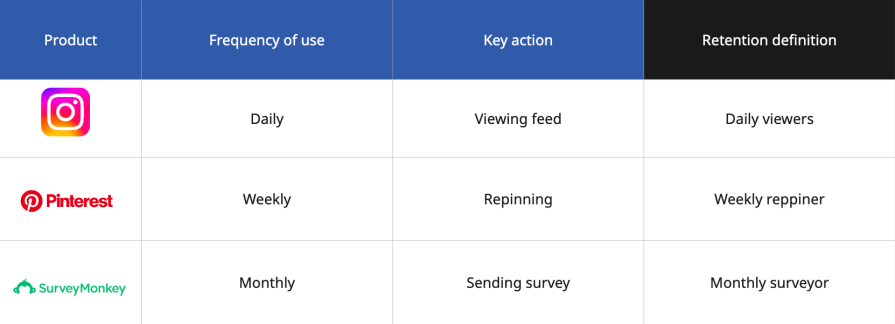How to define a good retention metric for your product
Retention is a core concept in product management, but it’s also one of the most commonly misunderstood.
The way you define your retention metric impacts the way you work, what you focus on, and how you interpret results. And the truth is, many companies make one particular mistake that turns a potentially powerful measure of success into a useless vanity metric.
The bottom line is that retention is about much more than just if users come back to your product or not.
Let’s dig deeper.
What’s retention, and why does it matter?
Retention tells you what percentage of users continue to get the value from the product over time.
The value part is important.
It’s not about users just logging in on a daily basis or visiting your website for a couple of seconds. It’s about actually delivering value.
That’s how you build meaningful habits around your products, and these habits later translate to business success.
Common mistakes when defining retention
The biggest mistake I see is defining retention as “daily/weekly/active user,” regardless of what the activity really was.
Just take this exaggerated example. If a user comes back every single day to your product just to get an error that they can’t log in, is that really a reason to celebrate? That’s just a noise.
The second mistake is not understanding frequency.
Should you measure daily retention? Weekly? Bi-weekly? Monthly?
Many teams seem to decide blindly, often based on which of those metrics looks better. That’s another source of noise that makes the retention metric less actionable.
Steps to defining a good retention metric
A great retention metric takes into account two critical dimensions
- Natural frequency of use
- Value generation
This is the most accurate measure of determining whether your product delivers value over time to your customers in a way it should.
To get started, follow these steps:
1. Understand the natural frequency of use
Different types of products are used at different frequencies. It all depends on how often the need actually occurs.
Take a look at Instagram:
- Problem it solves — Boredom
- How often the problem occurs — Daily
The problem Instagram solves for occurs on a daily basis, so measuring retention as “daily” makes sense.
But what about SurveyMonkey?
- The problem it solves — Gaining insights from customers
- How often the problem occurs — At least once a month
Tracking daily retention for SurveyMonkey wouldn’t make sense — people don’t create and send out new surveys every single day.
Or take TurboTax as another example. You don’t do your taxes daily. You don’t even do them monthly. So, what good would be daily or monthly retention here?
Understanding what problem your product solves and how often it occurs is the first step in defining a good retention metric.
2. Define a key action that indicates value
Now that you understand how often to track… you need to figure out what to track.
As I already mentioned, tracking “any activity” introduces a lot of noise and creates a metric that’s really hard to optimize and act on.
Instead, focus on value-generating actions. Ask yourself: What’s a single action that indicates that users got value from your product?
Instagram deals with boredom by giving users a feed of photos/shorts/reels, so you can assume that if someone views it, they alleviate their boredom.
SurveyMonkey is all about gathering insights from customers. You can assume that it happens when one actually creates and sends out a survey.
Those are the actions you want to track in your retention metric — not just any activity.
3. Combine both
A truly actionable retention metric considers the natural frequency that the problem appears with a key action that indicates value.
Let’s return to our previous examples:
Instagram:
- How often the problem occurs — Daily
- What’s the key action that indicates solving the problem — Viewing the feed
- Retention metric that makes sense — Daily feed viewers
SurveyMonkey:
- How often the problem occurs — Monthly
- What’s the key action that indicates solving the problem — Sending a survey
- Retention metric that makes sense — Monthly surveyors
For SurveyMonkey, understanding what percentage of users keep sending out surveys month over month is a truly great proxy of value. This is more relevant than just tracking active users, as just logging in doesn’t mean people used the platform to alleviate their problems.
Strategies for ad-hoc products
You might be thinking: What about products that you use on an ad-hoc basis? Say, once or twice a year?
For these, you simply don’t define a retention metric. It doesn’t make sense.
Products used less than once a month are in what is called the “forgettable zone” — you can’t really build a habit around these.
And if you can’t build a habit there, how would a retention metric impact your product development? It would just be another noisy metric that doesn’t tell you anything meaningful.
There are two ways to approach this scenario:
Brand awareness
Focus on building strong brand awareness through campaigns, marketing, and so on, so that your product comes to the top of users’ minds whenever the problem you solve occurs.
TurboTax does a great job here. You use it very rarely, but almost everyone knows what it is. And if they don’t, it’s one of the first things that appear when you search for tax solutions.
Support with more frequent use cases
Another strategy is to build products that are used monthly or more frequently.
Take Zillow, for example. You don’t buy a new house on a monthly basis but Zillow stays on top of customers’ minds by providing products that solve more frequent pain points.
Zillow Zestimate allows users to estimate the value of their home — something many people do on a monthly basis.
Zillow’s blog provides valuable insights on home renovation and management, something useful on a weekly basis:
That allows Zillow to build habits and track retention on side products, which later contributes to the sales it does on the main product.
By optimizing two retention metrics for two of its side products, it’s optimizing the chances that the next time someone wants to buy or sell their house, they’ll have Zillow at the top of their mind.
Final thoughts
Retention is a critical metric for many products. When defined properly, it indicates how well you’re establishing habits around your products.
Sadly, many product managers make the mistake of lazily defining retention as DAU / WAU / MAU. While it gives you some signals on your product performance, it doesn’t tell the full story.
A great retention metric answers the question: Do our users solve their problem with your product whenever it occurs? For that, you need to understand how often the problem actually occurs and how exactly your product helps to solve the problem.
A retention metric defined in that way is a solid measure of how good you are at establishing habits around your product. You can then use this retention metric to evaluate how your habit-building features perform and what impact they actually have.
Don’t measure retention just for the sake of measuring retention; measure retention as an indicator of habit-formation you can act on.
Featured image source: IconScout
The post How to define a good retention metric for your product appeared first on LogRocket Blog.
This post first appeared on Read More






